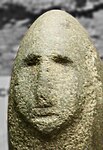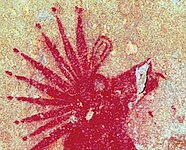Karakol culture
Location of the Karakol culture, with main contemporary cultures | |
| Geographical range | Altai |
|---|---|
| Period | Bronze Age |
| Dates | c. 2000 BCE |
| Preceded by | Afanasiev culture |
| Followed by | Karasuk culture |

50°46′23″N 86°27′50″E / 50.77306°N 86.46389°E
Karakol culture (Russian: Каракольская культура Karakol'skaya kul'tura) is a Bronze Age archaeological culture of the 2nd millennium BCE in the Altai area, consecutive to the Afanasiev culture. Karakol culture was discovered in 1985 near village of Karakol in Altai. In the Altai territory, the Bronze Age extended from the 3rd to the 2nd millennium BCE, bronze was a main material for tools, weapons and jewelry. At that time in the Altai territory lived people of the Karakol and Afanasiev cultures. Most of the investigated Karakol culture burials are located on the banks of the river Ursul and its tributaries.
Economy[edit]
In the Bronze Age, Altai populations transitioned from hunter-gathering to productive economy, from the hunting, plants-gathering and fishing to livestock-breeding and agriculture. The early Altaians in the summer grazed herds of cows, horses, and flocks of sheep and goats on alpine meadows, in the winter they were coming back to the river valleys; they also cultivated fields and grew millet, barley, rye, and other cereal plants.
Archaeology[edit]
Burials were in kurgans with circular enclosures, some burials in stone boxes, and ground grave-pits enclosed with massive stone slabs. Grave inventory is found infrequently. People were buried in rectangular boxes of hewn stone slabs, with many slabs with round hollows or holes and decorated with drawings of colored mineral pigments on inner side. Deceased were laid head to the west, facing the east. Coloured pictures in red, black, and white depict anthropomorphous creatures with feather crowns or with horns, with anthropomorphous masks and with costumes and sleeve ornaments. The pictures of birds, goats, elks, and people were made by cutting point technique. According to researchers, depicted animals and fantastic creatures on the inner side of the slabs "carried" the deceased to the afterlife. One of the figures depicted a man with a dog's head.
The stone vaults of Karakol culture contain coals and ashes. This element of the spiritual and religious culture is preserved in the Altai Mountains to this day. The modern Altaian ritual practices include fire for ritual cleansing.
-
Karakol culture artifacts
-
Karakol culture artifacts
-
Karakol culture portrait
-
Deity on a funeral slab, Karakol culture
-
Decoration of funeral slabs, Karakol culture
-
Decoration of funeral slabs, Karakol culture
Genetic composition[edit]
Results of correlation between traditional anthropological group-differentiating complex of craniometrical and odontological traits with the markers of mitochondrial DNA were presented in the Professorial dissertation of T.A. Chikisheva, 2010.
A Karakol female individual was recently excavated in the village of Mendur-Sokkon in the Altai Mountains. The burial is dated to circa 2,000 BCE. The features of the cranium were "intermediate Caucasoid-Mongoloid", similar to other individuals excavated in Ozernoye and Karakol in Central Altai. It is also quite similar to individuals from the Okunevo culture in the Minusinsk depression.[1]
-
Karakol culture burial, village of Mendur-Sokkon.[1]
-
Ceramic vessel from the burial in the village of Mendur-Sokkon (side view, bottom view).[1]
-
Reconstruction of a Karakol culture female individual (Altai Mountains village of Mendur-Sokkon, circa 2000 BCE).[1]
References[edit]
| Preceded by the Pleistocene |
| Holocene Epoch |
|---|
|
|
Blytt–Sernander stages/ages
*Relative to year 2000 (b2k). †Relative to year 1950 (BP/Before "Present"). |
- ^ a b c d Киреев, С. М.; Солодовников, К. Н.; Нечвалода, А. И. (19 March 2020). "BURIAL OF THE KARAKOL BRONZE AGE CULTURE IN THE ALTAI MOUNTAINS IN THE MENDUR-SOKKON VILLAGE (Preliminary Results of an Archaeological and Paleoanthropological Study) ПОГРЕБЕНИЕ КАРАКОЛЬСКОЙ КУЛЬТУРЫ ЭПОХИ БРОНЗЫ ГОРНОГО АЛТАЯ В С. МЕНДУР-СОККОН (предварительные результаты археологического и палеоантропологического исследования)". Theory and Practice of Archaeological Research Теория и практика археологических исследований (in Russian). 29 (1): 110–121. doi:10.14258/tpai(2020)1(29).-07. ISSN 2712-8202.
From the abstract in English: "The burial is dated to the end of 3rd – beginning of the 2nd millennium BC. The craniological features of the local anthro-pological component of the composition of the early bronze cultures of southern Siberia with intermediate Caucasoid-Mongoloid racial features are clearly manifested on the skull of a woman from Mendur-Sokkon. One can argue about the great morphological similarity of the buried with individuals buried in the unified cultural burials of Ozernoye and Karakol in Central Altai. On a territorially wider scale, the skull of a woman from a burial in the village of Mendur-Sokkon resembles the craniological series of the Okunevo culture of the Minusinsk depression, which of all the cultural formations of the early bronze of southern and southern Western Siberia anthropologically is the most related to the Karakol one."
Literature[edit]
- Kubarev V.D. "Ancient paintings of Karakol", Novosibirsk: Science, 1988 (In Russian)
- Molodin V.I. "Karakol Culture"//Materiaals on Okunev 2 culture and its surroundings, St. Petersburg: Elexis Print, 2006 (In Russian)
- Molodin V.I., Romashchenko A.G., Voivod M.I., Sitnikov V.V., Chikisheva T. "Paleogenetic analysis of the Siberia population gene pool"//Integral Program for Basic Research, Novosibirsk: Siberian Branch of RAS, 1998
- Chikisheva T.A., "Dynamics of anthropological differentiation in population of southern Western Siberia in Neolithic – Early Iron Age", Professorial dissertation, Novosibirsk, 2010, section Conclusions (In Russian)








![Karakol culture burial, village of Mendur-Sokkon.[1]](http://upload.wikimedia.org/wikipedia/commons/thumb/8/87/Karakol_culture_burial_in_the_village_of_Mendur-Sokkon.jpg/300px-Karakol_culture_burial_in_the_village_of_Mendur-Sokkon.jpg)
![Ceramic vessel from the burial in the village of Mendur-Sokkon (side view, bottom view).[1]](http://upload.wikimedia.org/wikipedia/commons/thumb/c/c0/Ceramic_vessel_from_a_burial_in_the_village_of_Mendur-Sokkon_%28side_view%2C_bottom_view%29.jpg/283px-Ceramic_vessel_from_a_burial_in_the_village_of_Mendur-Sokkon_%28side_view%2C_bottom_view%29.jpg)
![Reconstruction of a Karakol culture female individual (Altai Mountains village of Mendur-Sokkon, circa 2000 BCE).[1]](http://upload.wikimedia.org/wikipedia/commons/thumb/0/0e/Reconstruction_of_a_Karakol_culture_individual_%28Altai_Mountains_village_of_Mendur-Sokkon%29.jpg/300px-Reconstruction_of_a_Karakol_culture_individual_%28Altai_Mountains_village_of_Mendur-Sokkon%29.jpg)